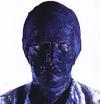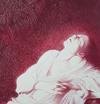Press and Media
The Guardian – May 16, 2000
One-man show at the Robert Sandelson Gallery, London, 2000
GOTTFRIED HELNWEIN, THE MAN WHO USED HIS OWN BLOOD TO PAINT HITLER
Kate Connolly meets Gottfried Helnwein, the Austrian who is still confronting his country's Nazi past. It could have been worse. At least he doesn't look like his self-portraits, in which bandages swathe his head, bent forks pull his mouth into a mocking smile and blood drenches his torso. Helnwein, 52, is a master of the scandalous and the art of shocking. The artist Robert Crumb once said of him: "Helnwein is a very fine artist and one sick motherfucker." "You can get things moving in a very subtle way, you can get even the strong and powerful to slide and totter - anything, actually, if you know the weak points and tap at them ever so gently by aesthetic means."

Walking along Cork street in central London, trying to locate the Robert Sandelson Gallery, I do a double take on seeing Mick Jagger standing at number 5a, gazing through a paneless window. He has a 70s hairstyle, carved cheeks, and angular nose, arms folded and face expressionless as he observes the workmen labouring to reinsert the glass. The whole tableau recalls some contrived album cover. Except it isn't Jagger, but one of his biggest fans, Austrian artist Gottfried Helnwein.
It could have been worse. At least he doesn't look like his self-portraits, in which bandages swathe his head, bent forks pull his mouth into a mocking smile and blood drenches his torso. Helnwein, 52, is a master of the scandalous and the art of shocking. The artist Robert Crumb once said of him: "Helnwein is a very fine artist and one sick motherfucker."
He earned his first gallery show in the 70s by driving around his native Vienna dressed in Nazi uniform, his head bandaged, fake blood trickling from his mouth. It caught the eye of an art dealer who signed him up and has remained faithful to Austria's enfant terrible ever since.
The decision to become an artist came to Helnwein "in a split second" at the age of 18, he says. "I saw it as the only way to find answers to the questions that no one in Austria would give me, such as why the post-war republic portrayed itself as the first victim of the Nazis rather than as one of the main perpetrators."
He enrolled at the Experimental Institute for Higher Graphic Instruction in Vienna, but soon got bored. One day he took a razor blade and cut his palms, using the blood to paint a portrait of Adolf Hitler. The academies stormed in, confiscated the painting and Helnwein was expelled. "This was the moment when I sensed for the first time that you can change something with aesthetics," he says. "You can get things moving in a very subtle way, you can get even the strong and powerful to slide and totter - anything, actually, if you know the weak points and tap at them ever so gently by aesthetic means."
He painted more Hitler portraits throughout the 70s. They attracted attentions from everyone, from concentration camp victims to SS officers, most of whom opened up to him. Somehow neo-Nazis got to hear of his pictures, knocking on his studio door to say, "We've heard you have a painting of the Führer. Can we come in?" According to Helnwein they confided in him their dreams of German supremacy and told him how they were infiltrating the far-right Freedom Party. Now, Helnwein has clear opinions on Jörg Haider and his party's blitzschnell rise to government; but he seems typically wary of being labelled as having an anti-Haider agenda. "I cannot understand why everyone makes so much fuss now," he says. "The situation was far worse in the past, when the former Freedom Party leader [Friedrich Peter] was an SS soldier who had been involved in the exterminations. Everyone knew about it and it was well documented, but he always said, 'I don't remember,' and everyone accepted that."
But as with his repressive Roman Catholic upbringing, it seems that Helnwein, born in 1948, will never escape the Nazi theme (in fact, he sees the two traditions as inextricably linked). Spurred into action by an interview in an Austrian tabloid in which the country's top court psychiatrist, Dr Heinrich Gross, admitted killing children at Vienna's Am Spiegelgrund Paediatric Unit during the war by poisoning their food, Helnwein painted Life not Worth Living - a watercolour of a little girl "asleep" on the table, her head in her plate. The painting sparked a nation-wide debate that finally led to Gross appearing before a Vienna court in March. The judge ruled Gross was mentally unfit to be tried. Outside the courtroom I met relatives of the alleged child victims, bearing photographs of them: their bellies distended from drug experimentation, their skulls clamped in head-measuring instruments. The brains of more than 400 of them ended up pickled in jars in the basement of the hospital where Gross experimented on them.
Helnwein's first solo show in the UK consists largely of frail and tender formaldehyde-yellow or x-ray blue images of pre-natal babies and children, reflecting the horror of the Nazi euthanasia programme, but brought close to the 21st century by the freshness of the Gross story. The huge portraits have been reworked from deformed teratological images from Austria's Anatomical Museum. Another exhibit, the Epiphany, shows uniformed Nazi soldiers inspecting a naked baby "Jesus" who is held by a beautiful Aryan goddess. The widow of one of the Nazi officers threatened to sue Helnwein for the unauthorised use of the image of her husband.
Children and child abuse have long been a central theme in Helnwein's work, "years before anyone would dare talk about it," he says. The images of seemingly innocent children in compromising positions, with a threatening look of experience in their eyes, have the ring of Mapplethorpe about them. He depicts not the act of violence but, perhaps more disturbingly, the result of the violence, as in the 1971 watercolour Embarrassing, which shows a child in her Sunday best, with a serious harelip and a squint, sitting on the floor against a white wall. Her emaciated right arm dangles, her bandaged left hand is placed on a comic book.
According to Alexander Borowsky, curator of contemporary art at the state Russian Museum, St. Petersburg, comic books gave the teenage Helnwein his "Damascus experience". His allegiance to Walt Disney and youthful experience of arch-conservative catholicism prompt him to describe Donald Duck and Jesus in his art. "When I opened my first comic," Helnwein says, "I felt like someone who has been buried in a mining accident and emerges into the daylight again after days in the dark. I was back home in a reasonable world where one could be flattened by road rollers or riddled with a hundred bullets without being harmed - a world where people looked decent once more."
Helnwein sought to find this decency in the real world for years, and failed. He moved from to more liberal Cologne in Germany. Ten years later he upped and left Germany with wife, Renate and their four children. They found a new home in a castle near Cork, and says Helnwein, "we feel at home there like we have nowhere else before and there are good vibrations."
Asked how much of the attraction is to do with his tax-free status there as an artist, he says: "Because the authorities have such a respectful attitude towards artists there's a spirit there to create that you find nowhere else in the world. Even the fishermen understand where you're coming from." Moving house is as important to the restless Austrian as changing styles. He detests the Roy Lichtenstein format of one idea, one picture. The work of the self-styled "whirling dervish of the art world" spans an incredible range of media from sculpture to photography to etching. "I try to escape the seduction of a certain medium," he explains. "I love to start something new with all the risks and the uncertainty." It is the equivalent, he says of colonic irrigation - the only way to avoid artistic blockage and complacency.
16.May.2000 The Guardian Kate Connolly


